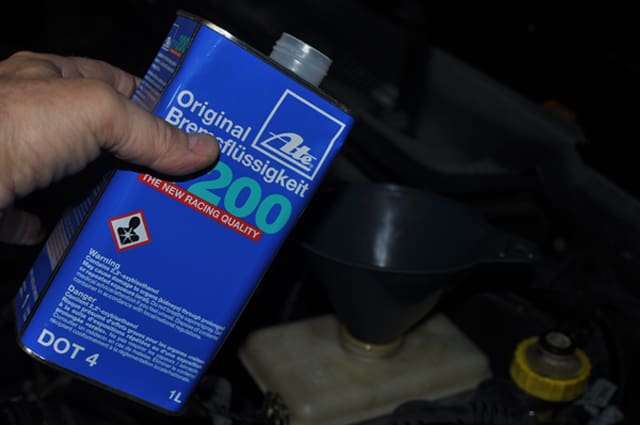Affiliate link disclosure – The BMW Repair Guide uses affiliate links in their site. For more information on affiliate links, please click here.
Repair Summary
The following article gives detailed instructions on performing a brake flush on a BMW E36 3 series car. Even though we have used a 1996 BMW M3 to perform this procedure, this article can be applied to any 1990-1998 BMW E36 vehicle with minor modifications.
See all vehicles this article applies to
E36 3 Series 316i
E36 3 Series 318is
E36 3 Series M3
E36 3 Series 320i
E36 3 Series 325i
E36 3 Series 325is
E36 3 Series 323i
E36 3 Series 328i
E36 3 Series 318i
E36 3 Series 323i 2.4
E36 3 Series 325td
E36 3 Series 325tds
E36 3 Series 318tds
E36 3 Series 316i 1.6
E36 3 Series 323ti
E36 3 Series 318ti
E36 3 Series 316g
E36 3 Series 316i 1.9
A BMW E36 brake flush is recommended every 24 months to keep your lines and calipers free from corrosion and your brakes operating properly.
We thought about that statement for quite a while before writing it and yes, we have grossly understated the obvious; a brake fluid flush is not pretty important, it's extremely important. But we think it is a good general representation of how many of us perceive our BMW brake systems...that they are well-engineered, low-maintenance mechanisms that only need attention every few years. Nothing could be further from the truth.
Brake fluid is hygroscopic. Like the cellulose fibers of a cotton ball a car's brake fluid will absorb water, wreaking havoc to metal brake lines, fittings, and caliper parts. Water in a car's brake system will also lower the boiling point of the brake fluid, causing a substantial decrease in braking power when the calipers heat up. And you don't have to be doing laps on the track to become a victim of a "spongy" brake pedal...daily city driving can cause significant heat to build up in the brake fluid as well.
If never maintained, a car's brake system will eventually fail with potentially catastrophic consequences. Brake lines and calipers become corroded with age and neglect. The Repair Guide recommends conducting a BMW E36 brake fluid flush every 24 months whether the car is driven or not. It is cheap insurance against having to replace expensive parts as your car gets older.
There are several ways to do a brake fluid flush on your BMW E36, but we highly recommend using a brake bleeder pump. It is extremely simple to use, and you can do the job by yourself (no brake pedal pumper needed). If you do not want to purchase a brake power bleeder kit, there are many other articles on the web that give instructions on alternative methods, such as vacuum bleeding and the "two-person" method.
A brake power bleeder is a plastic bottle that you pressurize with a pump handle, just like an ordinary poly spray bottle, you would have out in the garage to spray your yard for bugs. The only difference is the power bleeder has a pressure gauge and a special fitting that screws onto the top of your brake fluid reservoir. When you fill the power bleeder with brake fluid and pressurize the bottle (we recommend 20lbs), you have a continuous supply of fresh brake fluid being forced through your lines and out of the caliper bleed screw. The catch bottle that is also included in the kit is attached to the bleed screw with a slip-on rubber fitting and retains the fluid being forced out of the system. It has convenient lines embossed on it so you know the quantity that has been flushed out of your calipers.
**Brake fluid is extremely caustic to automotive paint. Take extra precautions not to spill any fluid on painted parts of your car. Also, make sure to dispose of any rags used to clean up brake fluid so they are not inadvertently used to wipe the finish of your car.
The BMW Repair Guide uses the Motive Power Bleeder Kit on all of their brake fluid flushes. It comes with a catch bottle with a rubber connector that fits snugly over the bleeder screw and eliminates any brake fluid from getting on the floor or the car.
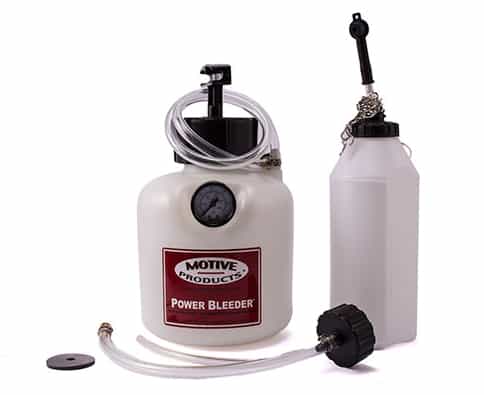



View the detailed parts diagram for this repair.
Includes detailed part diagrams, part numbers and links to purchase all of the required components needed to complete this repair.

Before starting this repair, you must have the following required parts.
Fits all BMW vehicles
Over time, brake fluid breaks down and no longer offers the same high boiling point and compression characteristics, both of which can be as dangerous on a track car as they can be on your grocery getter.
Section 1 - Preparing the Vehicle for a BMW E36 Brake Flush
- Jack up car and put on jack stands. Remove all 4 wheels. Not sure how to jack and support your BMW? Read our article on the simple and safest way by clicking here.
- Remove cap from brake fluid reservoir.
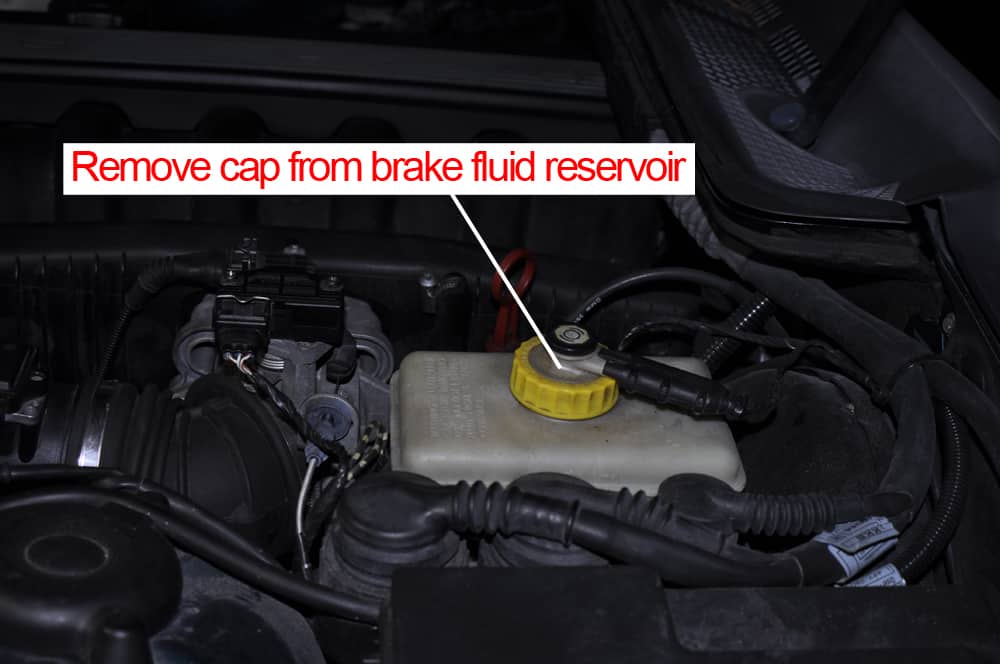
- Vacuum out old fluid with a vacuum pump or syringe. Just vacuum out until bottom of plastic reservoir is dry. **DO NOT vacuum fluid out of any hoses leading from bottom of reservoir. This may introduce air into the system.
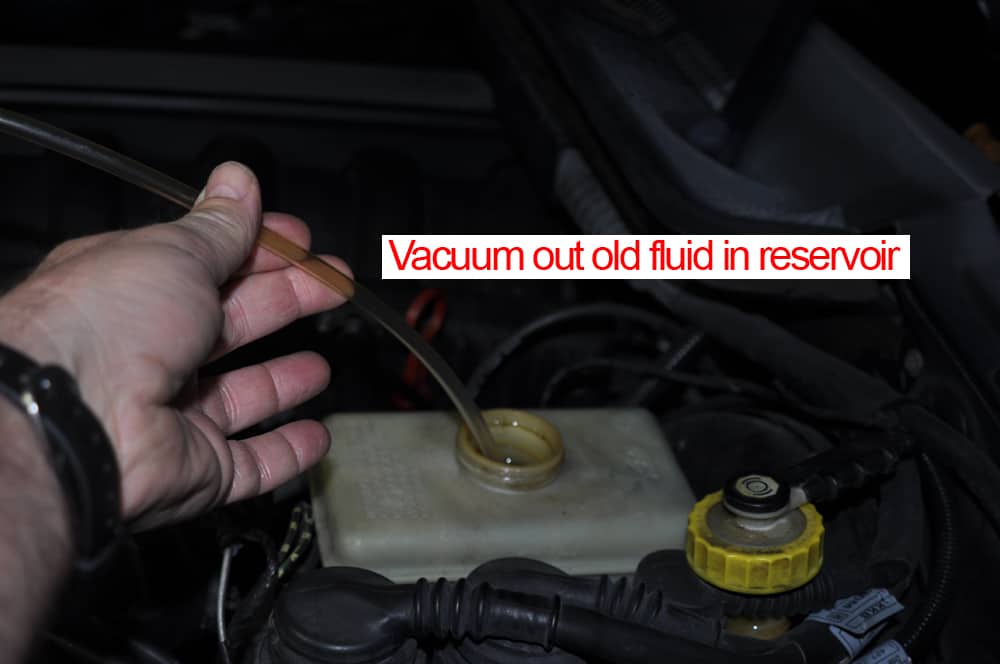
- Refill reservoir with fresh brake fluid. Do not overfill.
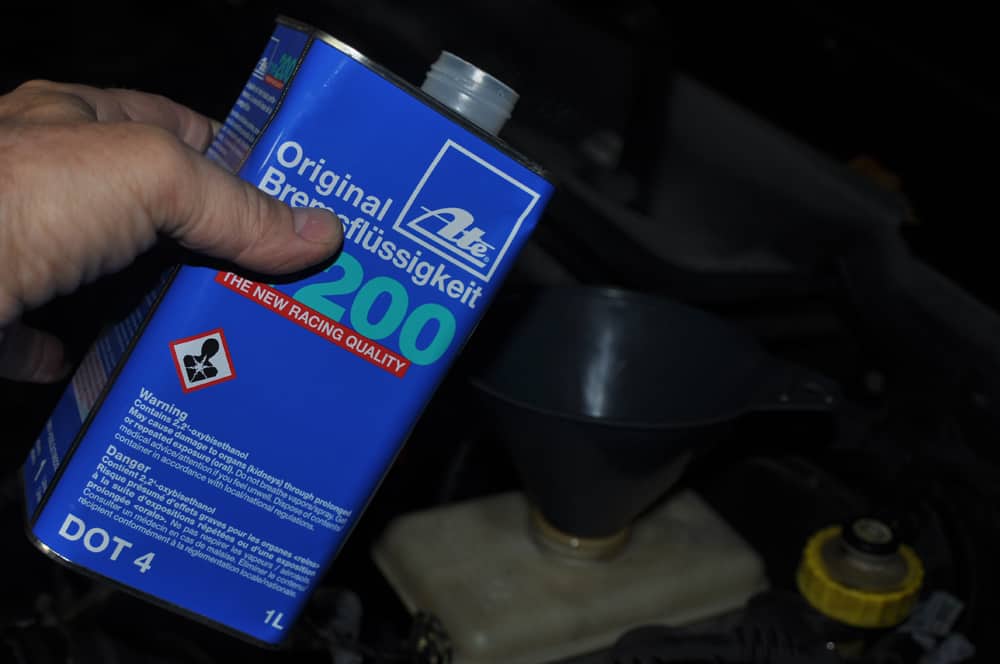
- Pour rest of can of brake fluid into power brake bleeder. Screw power brake bleeder fitting onto top of reservoir and pump tank to 20psi.

Section 2 - Bleeding the Brakes
Use the following bleeding pattern to properly flush your brake system: 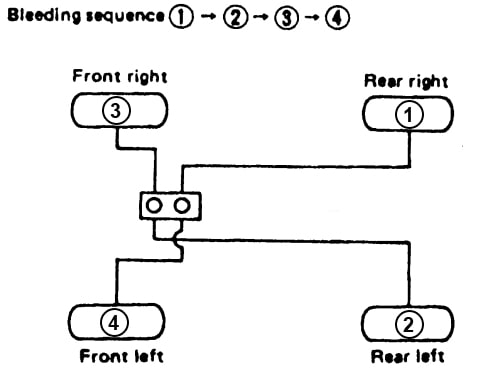 BMW E36 brake flush - bleeding pattern
BMW E36 brake flush - bleeding pattern - Check the power bleeder- it should have plenty of brake fluid in it and the pressure should be at 20psi.
- Starting with the right rear caliper, remove dust cover and place the 7mm open end wrench on the bleeder screw and turn counterclockwise until it breaks free. DO NOT open the screw so fluid comes out. The bleeder screws can sometimes freeze up over time, so the idea here is to just break it free before proceeding to step 3.
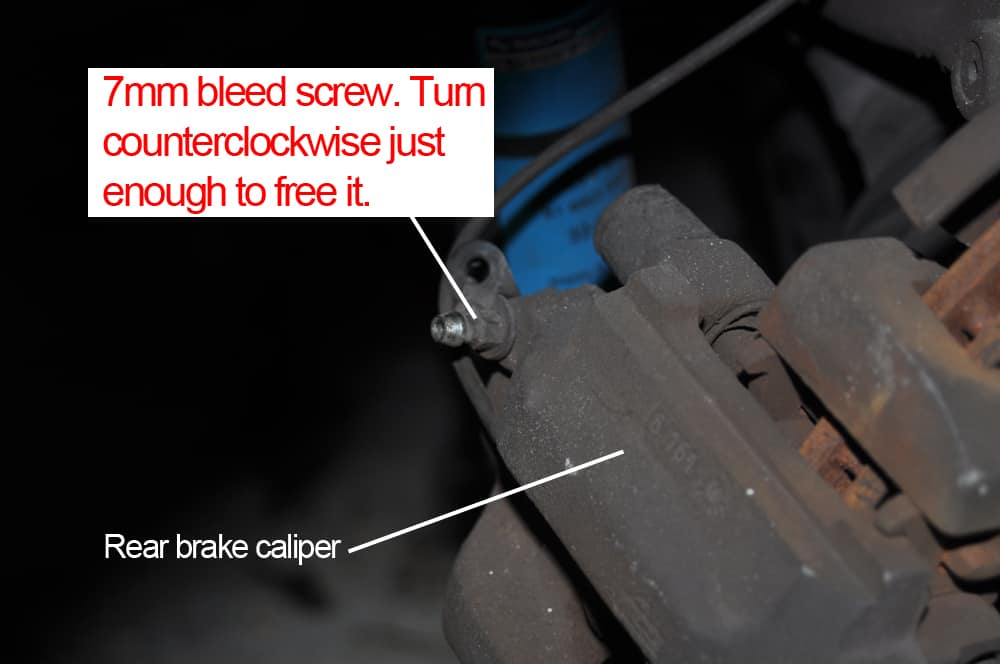
- Attach boxed end of 7mm open end wrench to bleeder screw, then attach rubber fitting of catch bottle to nipple of bleeder screw. Turn the screw counterclockwise until fluid begins to fill the bottle.
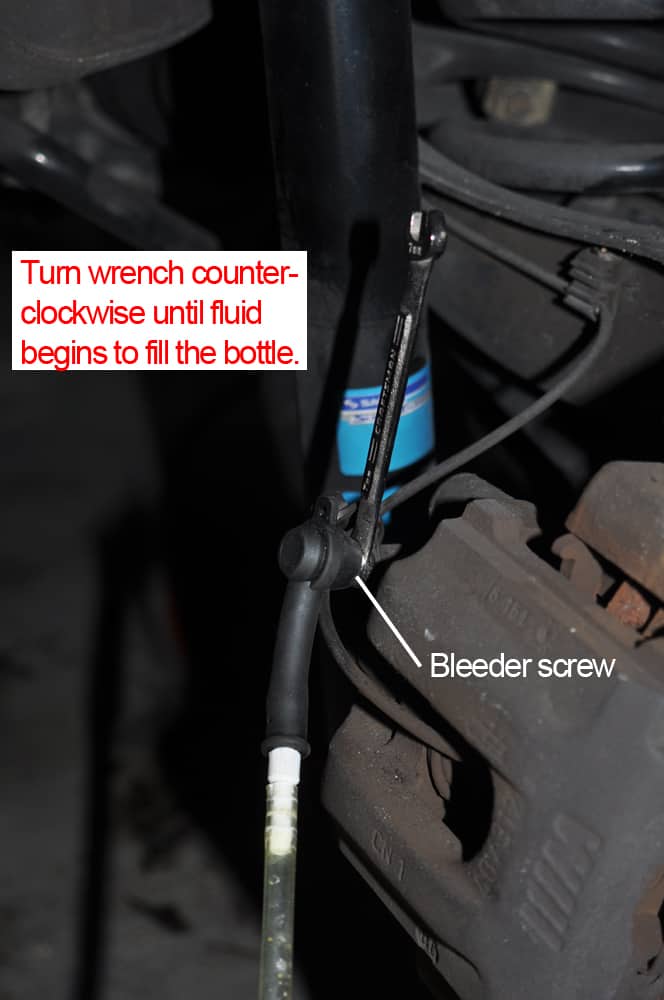
- While bottle is filling with fluid, continue to check power bleeder to make sure pressure is at 20psi and that there is plenty of fluid in the bottle.
- If at any time during the bleeding process the power bleeder runs low on fluid, STOP. Tighten bleeder screw immediately, add brake fluid to power bleeder, pump to 20 psi, then continue. This is very important so you do not introduce air into the brake system.
- You may have to make several trips back and forth between the power bleeder and the caliper to insure the bottle remains at 20psi and has plenty of fluid.
- When fluid in catch bottle reaches first measurement line (approximately 275ml), turn bleeder screw clockwise and tighten snugly (do not over-tighten).
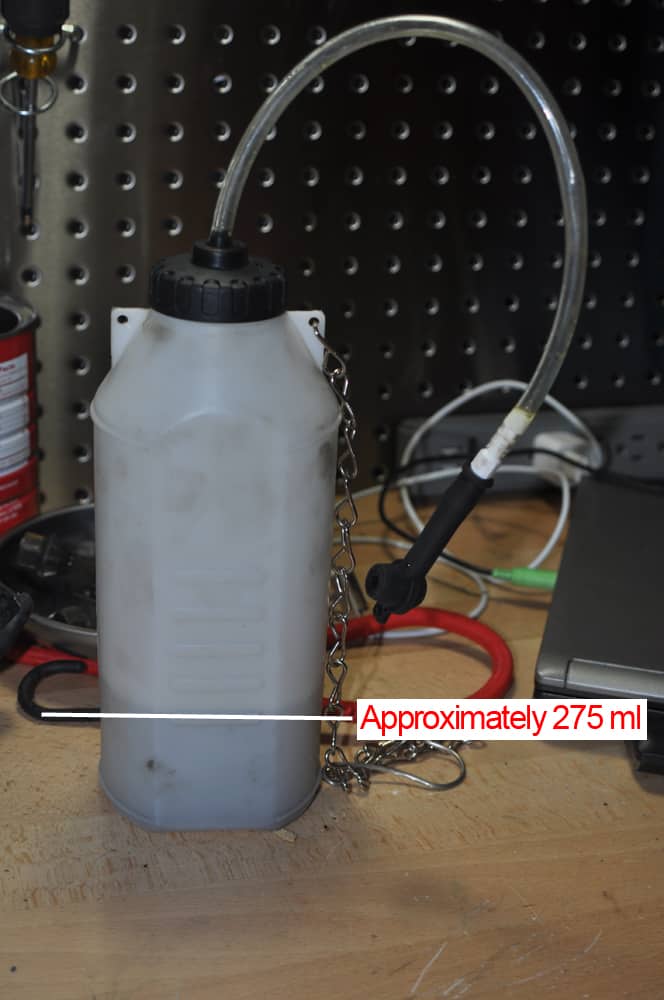
- Remove catch bottle and replace dust cap on bleeder screw.
- Proceed to next caliper following above instructions.
- After all of the calipers have been bled, remove power bleeder from brake fluid reservoir. Top off fluid in reservoir if needed.
- Replace cap on brake fluid reservoir.
- Replace wheels on car.
BMW E36 Brake Flush Finished

